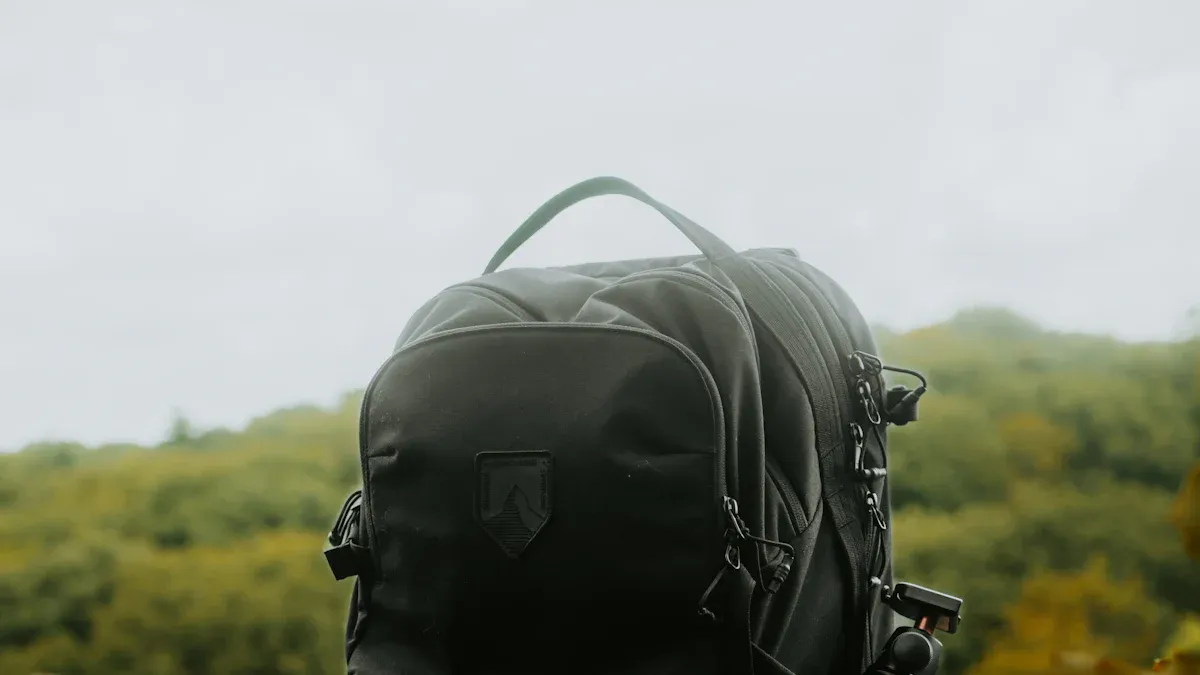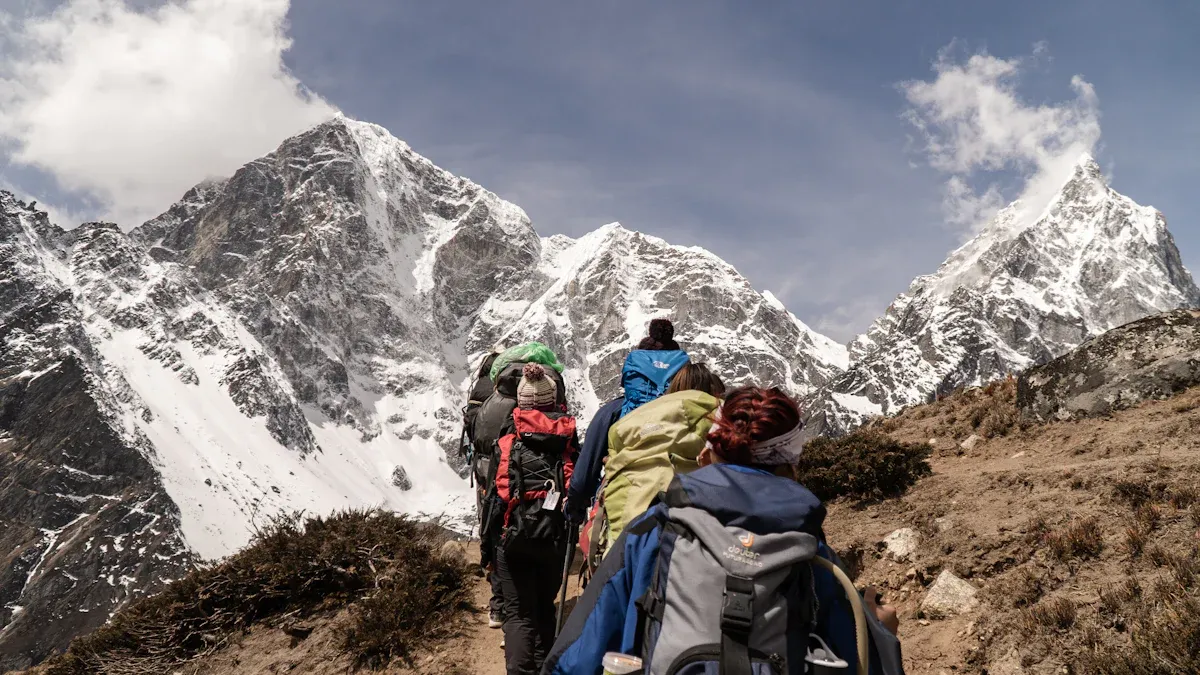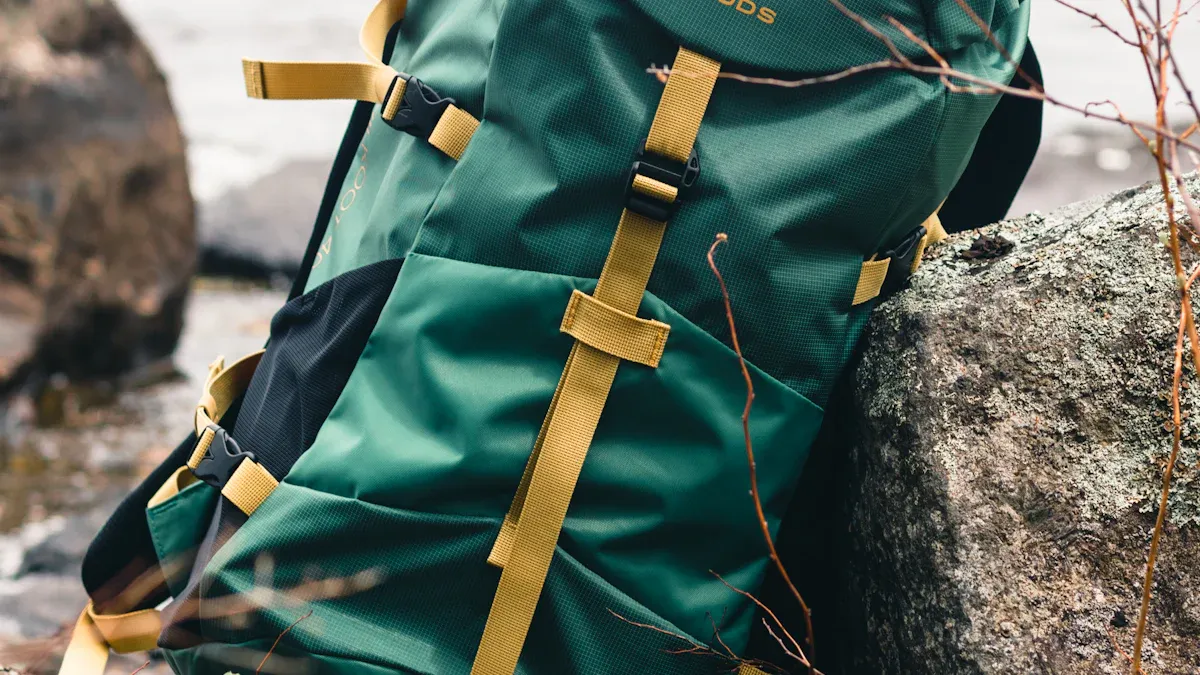
Selecting the right camping hiking outdoor backpacks plays a vital role in your outdoor experience. A well-designed pack enhances comfort by evenly distributing weight and preventing strain. Your hiking pack should accommodate your gear without feeling bulky. Prioritize a backpack that balances durability and functionality to ensure a seamless adventure.
Key Takeaways
- Pick a backpack that matches your trip. Short hikes need small packs (15-30 liters). Longer trips need bigger ones (30-70 liters).
- Make sure the backpack fits you well. Measure your torso and adjust the hip belt and straps. A good fit helps you stay comfortable and less tired.
- Check for important features like water storage, airflow, and waterproofing. These make hiking easier and keep your stuff safe outdoors.
Understanding Your Needs
Trip type: Day hike, overnight, or multiday
When you choose a backpack, the type of trip you plan plays a critical role. For a short day hike, lightweight day hiking packs with a capacity of 15-30 liters are ideal. They provide enough space for essentials like water, snacks, and a first-aid kit. Overnight trips require slightly larger backpacking packs, typically ranging from 30-50 liters, to accommodate sleeping gear and extra clothing. For multiday adventures, opt for multi-day packs with a capacity of 50-70 liters or more. These packs offer ample room for food, shelter, and additional equipment, ensuring you’re prepared for extended stays in the wilderness.
Trip intensity and terrain
The intensity of your hike and the terrain you’ll encounter should influence your choice. Steep, rugged trails demand durable and well-fitted backpacking packs for hiking that can handle uneven surfaces. Lightweight packs with excellent ventilation are better suited for moderate trails or warm climates. If you’re tackling a multi-day trek in remote areas, prioritize a pack with a sturdy frame and weatherproof features. These considerations ensure your backpack supports you effectively, regardless of the challenges you face.
Gear and essentials to carry
Packing the right gear is essential for safety and comfort. Your backpack should accommodate items like water bottles, navigation tools, and weather-appropriate clothing. For longer trips, include a hydration system, such as a hydration backpack, which offers hands-free access to water. The growing popularity of these packs highlights their convenience for hikers. Additionally, consider investing in reliable gear like the Geopress water purifier. It ensures access to clean drinking water in diverse environments, reducing reliance on single-use plastics. Durable and lightweight equipment enhances your experience, especially in areas where resupply options are limited.
Choosing the Right Size

Selecting the right size backpack is crucial for a comfortable and efficient hiking experience. A pack that is too small may leave you unprepared, while an oversized one can lead to unnecessary strain. Understanding backpack capacity, trip length recommendations, and the risks of overpacking or underpacking will help you choose the right backpack for your adventure.
Backpack capacity in liters
Backpack capacity is measured in liters, which indicates the volume available for storing your gear. The size you need depends on the type and duration of your trip. For day hikes, a small pack with a capacity of 20 liters is sufficient to carry essentials like water, snacks, and a first-aid kit. Weekend trips lasting 1-3 nights typically require a backpacking pack with a capacity of 30-50 liters. For longer adventures, such as multiday or extended trips, you’ll need a larger pack. Backpacks with a capacity of 50-80 liters or more can accommodate additional gear like sleeping bags, tents, and extra clothing. Choosing the right size pack ensures you have enough space without overloading yourself.
Ensuring a Good Fit for My Body
Choosing a backpack that fits your body properly is essential for hiking comfort and performance. A poorly fitted pack can lead to discomfort, fatigue, and even injuries. By focusing on key aspects like torso length, hip belt adjustments, and strap configurations, you can ensure your backpack enhances your outdoor experience.
Measuring torso length
Your torso length plays a crucial role in determining the right backpack fit. Backpacks are designed to align with your spine and distribute weight evenly, which minimizes strain during hikes. To measure your torso length:
- Locate the bony bump at the base of your neck (C7 vertebra).
- Find the top of your hip bones (iliac crest).
- Measure the distance between these two points along your spine.
Backpacks come in different sizes based on torso length, so knowing this measurement ensures you select a pack that matches your body. Scientific studies in ergonomics highlight the importance of this step. Ergonomists use anthropometry and biomechanics to design backpacks that fit individuals properly, reducing the risk of discomfort and injury.
Tip: Many outdoor gear stores offer free torso measurement services. Take advantage of these to ensure accuracy before purchasing your pack.
Hip belt size and adjustments
The hip belt is a critical component of your backpack. It supports the majority of the pack’s weight, transferring it to your hips and lower body for better stability. Aim for about 50-80% of the load to rest on your hips. To achieve this:
- Position the hip belt securely above your belt line.
- Tighten it snugly against your body to avoid pressure points.
- Adjust the waistbelt to ensure even weight distribution.
Proper hip belt adjustments enhance comfort and reduce fatigue during hikes. A well-fitted belt prevents strain on your shoulders and torso, allowing you to carry heavier loads with ease. Studies show that a correctly positioned waistbelt improves weight transfer, making long treks more manageable.
Note: If your hip belt feels loose or causes discomfort, revisit the adjustments. A small tweak can make a big difference in your backpacking experience.
Strap adjustments for comfort
Adjustable straps are essential for achieving a good fit for your body. They allow you to fine-tune the backpack’s position, ensuring weight is evenly distributed and reducing the risk of injuries. Focus on these key straps:
- Shoulder straps: Adjust them to pull the pack close to your back without causing strain.
- Chest strap: Secure it to stabilize the load and prevent the pack from shifting during movement.
- Load-lifter straps: Tighten them to bring the pack’s weight closer to your body, improving balance.
Research underscores the importance of adjustable straps in preventing hiking injuries. Proper strap configurations reduce fatigue and enhance comfort, especially on uneven trails. By taking the time to adjust these straps, you can ensure your backpack fits like a glove and supports you throughout your adventure.
Tip: Test your backpack with weight before hitting the trail. Simulating real use helps you identify and correct any strap-related issues.
Understanding the Features

Hydration compatibility
Hydration compatibility is a vital feature for hiking backpacks. Many models include designated compartments for hydration bladders, which typically hold 2 to 3 liters of water. These systems allow you to stay hydrated without stopping to retrieve a bottle. Look for packs with built-in hose ports and clips to secure the drinking tube. This setup ensures easy access to water during strenuous hikes. Hydration backpacks are especially useful for long treks, where consistent hydration is crucial for maintaining energy levels.
Ventilation and breathability
Ventilation and breathability play a significant role in your comfort during hikes. Advanced designs, like the Osprey Atmos 65 AG, feature innovative suspension systems that reduce heat buildup and improve airflow. These systems prevent excessive sweating, especially in warm climates or during intense activities. Mesh panels and breathable fabrics enhance airflow between your back and the pack, keeping you cool and comfortable. Prioritize backpacks with these features to avoid discomfort on challenging trails.
Pockets and compartment
s
Pockets and compartments improve organization and accessibility. Hip belt pockets provide convenient storage for small items like snacks or navigation tools. Larger compartments accommodate essential gear, ensuring everything has its place. Some packs include external pockets for quick access to frequently used items. Multiple compartments help distribute weight evenly, enhancing balance and reducing strain. Choose a backpack with ample storage options to keep your gear organized and within reach.
Rain covers and weatherproofing
Weatherproofing features protect your gear from rain and moisture. Many hiking backpacks include built-in rain covers that shield your pack during unexpected downpours. Durable materials, such as nylon or polyester, offer water resistance and prevent damage to your belongings. Look for packs with sealed seams and waterproof zippers for added protection. These features ensure your gear stays dry, even in harsh weather conditions.
